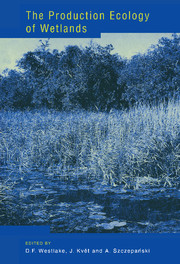Book contents
- Frontmatter
- Contents
- List of contributors
- Preface
- Foreword
- 1 General ecology of wetlands
- 2 Primary production in wetlands
- 3 Further fate of organic matter in wetlands
- 4 The role of decomposers in wetlands
- 5 The role of animals and animal communities in wetlands
- 6 Mineral economy and cycling of minerals in wetlands
- 7 Micro-climatic conditions and water economy of wetlands vegetation
- 8 The management of wetlands
- References
- Index
4 - The role of decomposers in wetlands
Published online by Cambridge University Press: 27 October 2009
- Frontmatter
- Contents
- List of contributors
- Preface
- Foreword
- 1 General ecology of wetlands
- 2 Primary production in wetlands
- 3 Further fate of organic matter in wetlands
- 4 The role of decomposers in wetlands
- 5 The role of animals and animal communities in wetlands
- 6 Mineral economy and cycling of minerals in wetlands
- 7 Micro-climatic conditions and water economy of wetlands vegetation
- 8 The management of wetlands
- References
- Index
Summary
Introduction
The organic matter produced by primary producers is subject to two basic decomposition processes.
Mineralisation This accompanies the assimilation of organic matter by different organisms, varying according to the level of organisation. Some of the substances are used for building their own biomass (secondary production), but the rest is released as mineral or simple organic compounds (e.g. K+, Na+, CO2, CH4, H2O, NH4+, NO3–, SO42–, CO (NH2)2,H2S, PO43-).
Humification This is a relatively long series of various fermentative and other biochemical processes, wherein different organic metabolites become gradually transformed into complex organic heteropolycondensates with bonds of different strength, called humus. The formation, as well as the decomposition and stability, of humic substances are affected to a considerable extent by bonding with some of the mineral constituents of the medium such as ions and clay minerals.
Different ecosystems can vary in their mineralisation/humification ratio, depending on the environmental conditions and the diversity of the organisms present. Individual structures of the wetland ecosystems, i.e. standing dead, litter, bottom sediments, soil and subsoils, vegetation zones, etc., are subjected to changing conditions of water level, thermal stratification, moisture content and air humidity in the course of the growing season. The feeding materials, sources of energy for microbial populations, vary as well, and change through the trophic levels.
- Type
- Chapter
- Information
- The Production Ecology of WetlandsThe IBP Synthesis, pp. 192 - 210Publisher: Cambridge University PressPrint publication year: 1999



